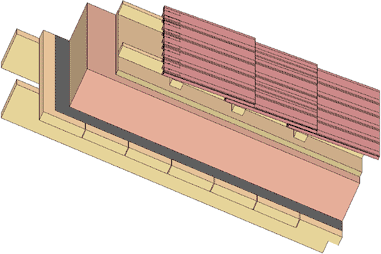Geprüftes/zugelassenes Bauteil
pitched roof sdshzx01-01
pitched roof exposed rafter, ventilated, -, without lining
Building physical assessment
| Fire performance | REI | 30 |
|---|---|---|
|
maximum span = 5 m; maximum load Ed,fi = 5,29 kN/m² (with exposed beams 180/240 and fire protection cladding)
Classified by IBS Classified by HFA
Fire performance Germany
Classification: F30
Load Ed,fi according to the German certification document
Proof: DIN 4102-4:2016-05, Tabelle 10.24, Zeile 1
|
||
| Thermal performance | U | 0,18 W/(m2K) |
| Diffusion | adequate | |
|
Calculated by HFA
Calculated by TUM
|
||
| Acoustic performance | Rw (C;Ctr) | 42 dB (-3; -8) |
| Ln,w (Cl) | ||
|
with a tiled roof Rw = 41 (-2; -8) dB
Assessed by TGM Rating by Müller-BBM
|
||
| Mass per unit area | m | 125,5 kg/m2 |
data sheet pitched roof
sdshzx01-01 (pdf, 250 KB)
Note
The design of the under-roof construction and of the counter-battens have to be specified according to the roof pitch and the national requirements.
Only for registered members after logging in.


Register of building materials used for this application, cross-section (from outside to inside)
| Thickness [mm] | Building material | Thermal performance | Reaction to fireklasse EN | ||||
|---|---|---|---|---|---|---|---|
| λ | μ min – max | ρ | c | ||||
| A | concrete roof tile or tiled roof | 2100 | A1 | ||||
| B | 30,0 | spruce wood battens (30/50) | 0,120 | 50 | 450 | 1,600 | D |
| C | 50,0 | spruce wood counter battens (Austria: minimum height 50 mm), Germany 30 mm | 0,120 | 50 | 450 | 1,600 | D |
| D | 22,0 | softboard [045; 250] - rigid underlay | 0,045 | 5 | 250 | 2,100 | E |
| E | 180,0 | wood-fibre insulation board [0,040; R=200] - insulation placed on top of the rafters | 0,040 | 5-7 | 200 | 2,100 | E |
| F | vapour barrier sd≥ 1m | 1000 | |||||
| G | 40,0 | spruce wood tongue and groove, fire protection cladding (Germany minimum 50 mm) | 0,120 | 50 | 450 | 1,600 | D |
| H | construction timber in acc. with structural design | 0,120 | 50 | 450 | 1,600 | D | |
Ecological rating (per m2 construction area)
Details of sustainability rating...
| Global warming potential | Share of renewable Primary Energy | Resources | |||||||||||
|---|---|---|---|---|---|---|---|---|---|---|---|---|---|
| Lifecycle Phase |
GWP-F [kgCO2Äqv.] |
GWP-B [kgCO2Äqv.] |
GWP-T [kgCO2Äqv.] |
PERE [MJ] |
PERM [MJ] |
PERT [MJ] |
PENRE [MJ] |
PENRM [MJ] |
PENRT [MJ] |
AP [kgSO2Äqv.] |
EP [kgPO4Äqv.] |
ODP [kgR11Äqv.] |
POCP [kgEthenÄqv.] |
| A1 - A3 | 50,732 | -116,445 | -65,713 | 172,408 | 1196,034 | 1368,442 | 725,938 | 87,289 | 813,227 | 0,189 | 0,086 | 3.9726485E-6 | 0,039 |
Details of sustainability rating...
| Resources | |||||||||||
|---|---|---|---|---|---|---|---|---|---|---|---|
| Lifecycle Phase |
GWP [kgCO2Äqv.] |
AP [kgSO2Äqv.] |
EP [kgPO4Äqv.] |
ODP [kgR11Äqv.] |
POCP [kgEthenÄqv.] |
PERE [MJ] |
PERM [MJ] |
PERT [MJ] |
PENRE [MJ] |
PENRM [MJ] |
PENRT [MJ] |
| A1 - A3 | -91,529 | 0,134 | 0,029 | 2.21E-6 | 0,031 | 446,851 | 1419,783 | 1866,499 | 811,625 | 61,682 | 873,443 |
| C1 - C4 | 136,470 | 0,010 | 0,001 | 1.29E-7 | 0,001 | 3,693 | -1421,149 | -1417,455 | 42,317 | -53,982 | -11,666 |
| A1 - C4 | 45,608 | 0,146 | 0,031 | 2.34E-6 | 0,032 | 451,241 | -1,366 | 449,741 | 863,076 | 7,700 | 870,912 |
Last update 02.08.2023/hfa.eco2soft